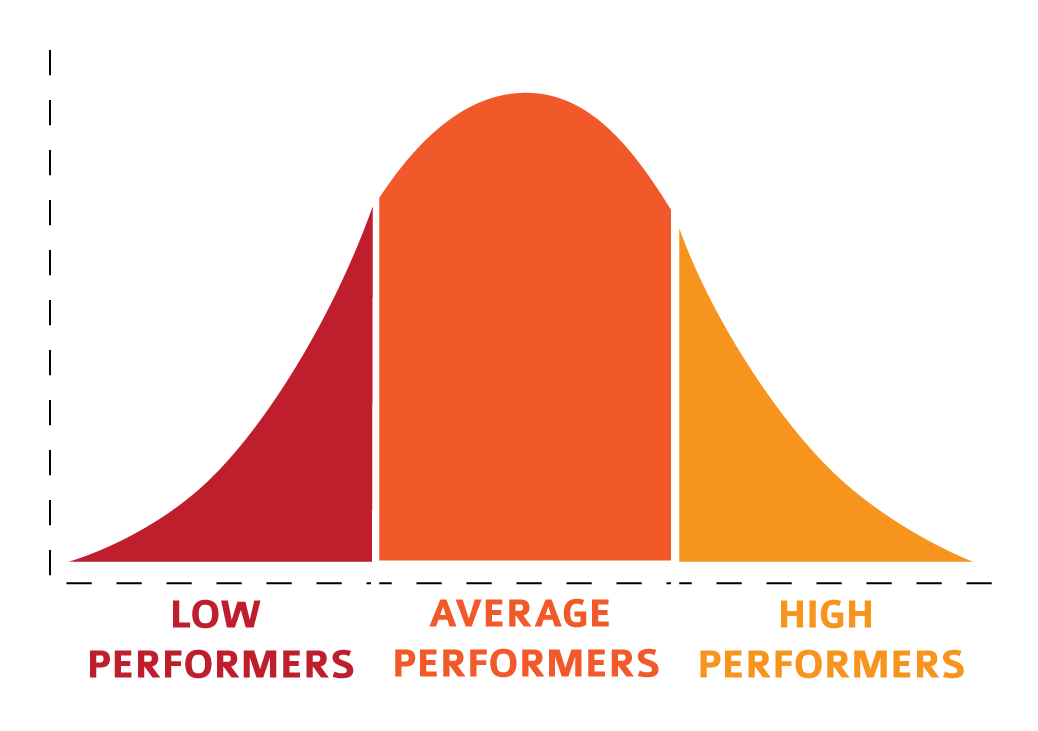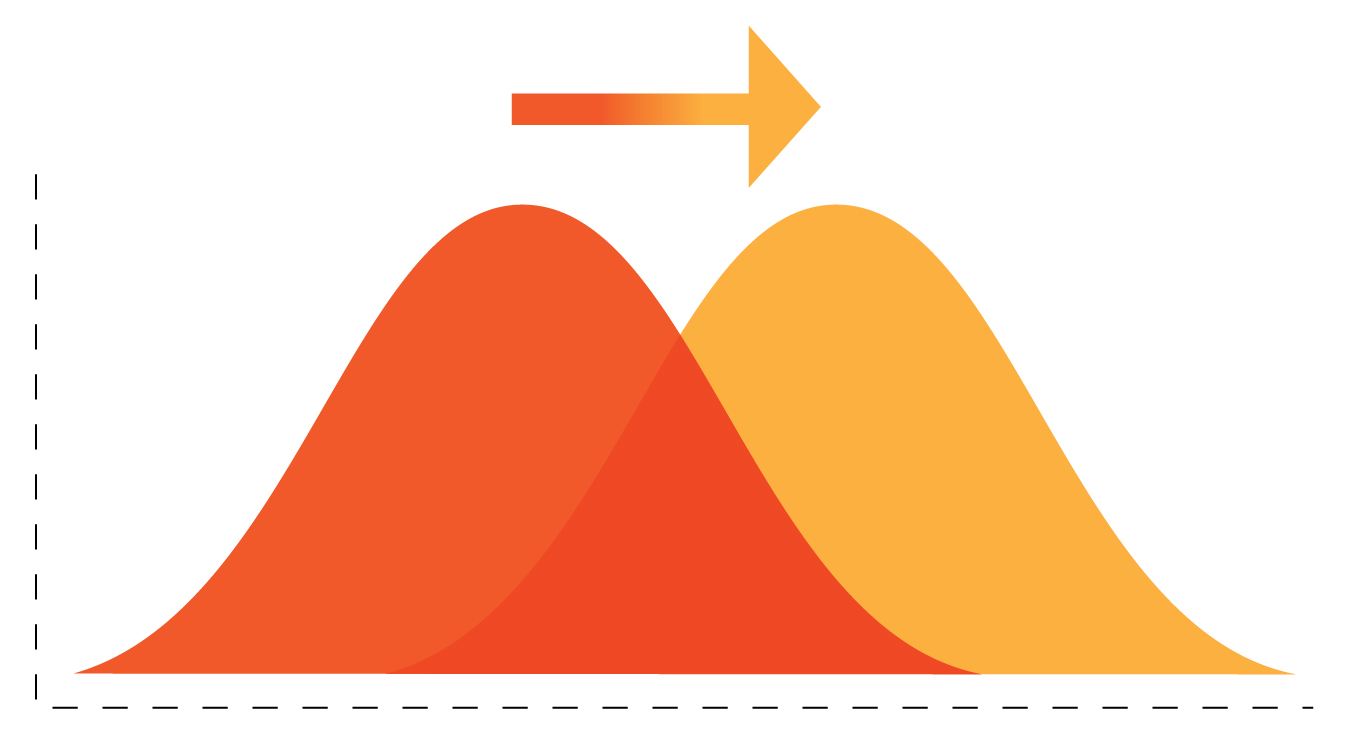The debate, if you can call it that—“jibber jabber” might be a better term (thanks, Mr. T!)—over linking student achievement data to teacher and principal performance started on the wrong foot and seems to be stuck hopping around on it. Using performance data to identify and reward rock star teachers and “weed out” the ones who probably should be in another profession only tinkers at the margins.
Take a typical bell curve for teachers, with student achievement outcomes as the measure of performance. Now, I don’t know what the exact shape of this curve looks like for public school teachers across the country, but notwithstanding the sad fact that the “The Widget Effect” study conducted by The New Teacher Project found 99 percent of all public school teachers get rated as “satisfactory” or better by district evaluation systems, let’s assume, for argument’s sake, that the true bell curve actually looks something like this:
 If the part of the curve that represents the poor performers is 10 percent of the total number of teachers, and if we were able to get rid of them all overnight, the next morning we’d still be left with 3.2 million of the same teachers who teach in public school classrooms every day. And while it often sounds like it (especially if you listen to the most strident promoters of achievement-based teacher evaluations), I don’t think anyone is actually advocating getting rid of, say, the lower half of the bell curve and trying to replace nearly two million teachers. There simply isn’t a pipeline of quality teachers who could fill those classrooms.
If the part of the curve that represents the poor performers is 10 percent of the total number of teachers, and if we were able to get rid of them all overnight, the next morning we’d still be left with 3.2 million of the same teachers who teach in public school classrooms every day. And while it often sounds like it (especially if you listen to the most strident promoters of achievement-based teacher evaluations), I don’t think anyone is actually advocating getting rid of, say, the lower half of the bell curve and trying to replace nearly two million teachers. There simply isn’t a pipeline of quality teachers who could fill those classrooms.
At the other end of the curve, the notion that paying high performers more will incent average teachers to step up their game is flawed on its face (as we’ve noted in previous blog postings here). But even if it weren’t, the additional money alone doesn’t help the average teachers know how they need to change their day-to-day actions to join the high performing ranks. Just knowing that great teachers can make a lot more money doesn’t tell you what successful teachers actually do.
In reality, the only way to truly improve overall teacher performance—and thereby improve student outcomes—is to move the entire bell curve to the right; essentially getting the overwhelming number of teachers in the “average” range to perform better.
 If that’s the goal, then emphasizing the use of student performance data for bonuses and firings is really missing the point. Instead, the data should be used first and foremost to manage performance: feedback to teachers to help them understand whether or not what they’re doing in the classroom is working; feedback to principals to help them target limited school-based resources (i.e., master teachers, mentors, observations, teaching assistants, etc.); and feedback to central office administrators to help them identify professional development that actually makes a difference and target it toward those who truly need it.
If that’s the goal, then emphasizing the use of student performance data for bonuses and firings is really missing the point. Instead, the data should be used first and foremost to manage performance: feedback to teachers to help them understand whether or not what they’re doing in the classroom is working; feedback to principals to help them target limited school-based resources (i.e., master teachers, mentors, observations, teaching assistants, etc.); and feedback to central office administrators to help them identify professional development that actually makes a difference and target it toward those who truly need it.
If districts and states stressed these and other less-threatening uses of performance data and spent the first two or three years of a reform initiative getting its teachers and principals comfortable with the necessity and helpfulness of performance data for managing and improving their behaviors and actions, there would be a lot less resistance—and a lot less jibber-jabber—when districts and states eventually start applying the data to high-stakes performance evaluations and merit pay.
At last — someone recognizing how we have been plagued by policies built on a belief that gathering and reporting “data” will somehow improve the way schools work. That kind of magical thinking supports and is supported by punitive approaches embedded in school cultures that neither help students nor improve teacher performance. Assessments ( of students and teachers) must do more then tell us what students know and which teachers are successful. Those kinds of “tests” are important but are only part of a comprehensive assessment process.
To be worth the resources we invest, assessments must have instructional value for teachers and students . As long as a “one size fits all” approach to curriculum and instruction continues to dominate public education, children will continue to fail. We need to move away from just testing students who don’t succeed to determine whether or not they are in need of special education. In addition, we must examine curriculum and instruction to determine whether or not teaching methods are appropriate for students’ strengths and needs. Assessment must be designed to examine instructional differentiation, i.e. to determine if teachers are teaching in ways that match students learning needs, interests and abilities. Teachers can then be assisted in developing more effective instructional strategies rather then being punished.
Trackbacks
Leave a Reply
The comments are closed.